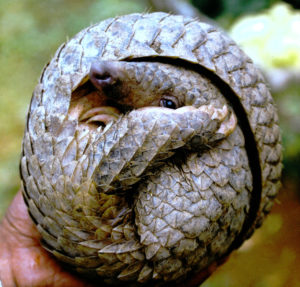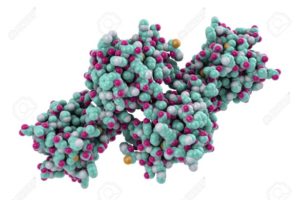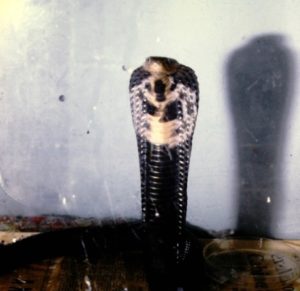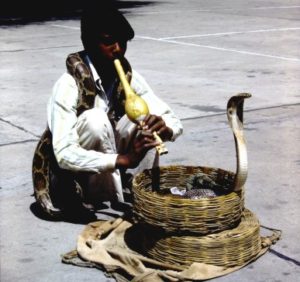When I first learned that I would be going to Malaysia as a Peace Corps-Smithsonian Institution Volunteer I was, to put it mildly, thrilled. Fortunately I was blessed by having an equally adventurous spouse and so, with seven year old daughter in tow, off we went.
The source of my excitement in contemplating our journey was two-fold I suppose. First, for reasons still not fully understood, I had been infected since childhood with an insatiable desire to travel to far, exotic places. Malaysia certainly fit the bill. It was about as distant from Sullivan, Indiana as one could travel upon the globe. Any farther from the Hoosier state and, as ancient mariners had postulated, one would be coming home again. Malaysia’s position as a British colony until the mid-twentieth century had resulted in a fascinating blend of ethnicities and cultures. This also suggested that there were sure to be cultural adventures revolving around food, customs, beliefs that would be both exciting and educational.
Naturally, as a biologist, there was the allure of the country’s rich natural history. For anyone intrigued by plants and animals, the very thought of visiting Malaysia was the stuff of dreams. This relatively small country was home to ten thousand species of flowering plants, two hundred kinds of mammals, and six hundred types of birds. Equally exciting, nearly one hundred and fifty species of snakes were endemic to this Southeast Asian nation (today over 200 species). What more could one want? So it was that, after a few weeks of language training, I found myself established in the biology department of  the University of Agriculture Malaysia or the Universiti Pertanian as it was then called. As soon as possible, I began to go on birding walks, make scouting forays for frogs, lizards, and snakes and peruse the literature on Malaysian mammals. All this was necessary because I would soon begin work as a lecturer in vertebrate zoology at the university. I needed to bring myself up to some degree of working knowledge regarding the local fauna and be quick about it.
the University of Agriculture Malaysia or the Universiti Pertanian as it was then called. As soon as possible, I began to go on birding walks, make scouting forays for frogs, lizards, and snakes and peruse the literature on Malaysian mammals. All this was necessary because I would soon begin work as a lecturer in vertebrate zoology at the university. I needed to bring myself up to some degree of working knowledge regarding the local fauna and be quick about it.
It wasn’t long before my interest in snakes became known within and around the campus. Not only was I concerned about learning all I could regarding the local snake fauna, I also needed specimens. I found the thought of trying to teach vertebrate zoology labs without museum specimens unsatisfactory. If the students were going to learn anything practical about their fauna, then it would be highly advantageous to be able to show them what a puff-faced water snake, a tokay gecko, or a house shrew actually looked like. So it was that one of my first endeavors was to begin to build a museum collection of vertebrate specimens for teaching purposes.
I soon found that a small monetary reward could generate a slow but steady flow of specimens in my direction. During the three years I spent in Malaysia snakes, frogs, toads, turtles, ands bats found their way to me via locals living near the university. Occasionally a rare or unique  specimen would be produced, a Malayan pangolin and a leopard cat for example. Although I remember many of these animals with fond aesthetic and scholarly interest, my recollection of the first Malaysian cobra I received stands out as a most unforgettable experience.
specimen would be produced, a Malayan pangolin and a leopard cat for example. Although I remember many of these animals with fond aesthetic and scholarly interest, my recollection of the first Malaysian cobra I received stands out as a most unforgettable experience.
I was sitting at my office desk preparing notes when a knock came at my door. Inviting them to enter, I found it was my lab assistant and budding friend Rajoo. The lab assistants at our university were not grad students as they were in the United States. Here they were people hired specifically for that position. As a result Rajoo was well into his forties and was married with children. He always called me Mr. George because he was accustomed to the Asian manner of having the surname appear first in a moniker. “Mr. George,” Rajoo said. “There is a fellow downstairs who has a cobra for you. It is in a bag.” I assumed he meant a cloth bag of the kind herpetologists used when bagging a snake. With excitement, I leaped from my chair and headed for the door. Suddenly, I was accompanied by the unbidden recollection of a line from Kipling’s The Jungle Book. Although the passage referred to another snake, the saw-scaled viper, it suddenly seemed quite appropriate. Of this snake Kipling wrote, “Something flinched a little in the dust, and a tiny voice said: Be careful. I am Death.”
Rajoo directed me to the lab where waited the chap with the snake. What a surprise when I saw the captor hold out not a cloth bag but one made of sturdy but transparent plastic. Inside this plastic bag was a very, very angry cobra.
The threat display of the cobras is quite impressive under any circumstances. Being a first encounter, and given at arm’s length, the exhibition within the confines of the translucent bag was spectacular. With hood fully spread, and its body reared as high as possible within its prison, the snake struck the inside of the bag ferociously. This was accompanied by explosive hissing. Actually, I question whether calling it a hiss is sufficient. The sound was more like the deep, explosive escape of steam from a high pressure pipe. All in all, the display was pretty damned intimidating which, of course, was its exact purpose.
I was to find, over the course of the next three years, that this particular cobra species was relatively common around the university campus. After all, it was an agriculture school initially. There were fields and crops and this meant rats. Malayan cobras are quite fond of rats as well as another favorite, toads. Generally speaking, subsequent cobras I encountered were more than willing to give ground and dart away given the chance. However if they found themselves cornered, as the present captive was, the snakes would put up a tremendous threat display. This was often accompanied by repeated strikes. These were regularly delivered with the mouth closed, simply part of the aposematic behavior as it is called. Make no mistake; the bite of one of these snakes is incredibly dangerous. Cobras are members of a group of snakes known as elapids. The elapids include not only cobras but kraits, coral snakes, and mambas. The venom of these snakes is highly neurotoxic. Symptoms of neurotoxic snake bite include  disturbing manifestations of neural paralysis such as drooping of the eyelids, drooling, numbness, tingling of the skin, and euphoria. These may escalate into truly life-threatening signs such as difficulty in breathing, shock, and respiratory failure. The effect of neurotoxins on the respiratory system has been likened to having another person sit on one’s chest while trying to breathe. Perhaps you will now understand why I looked forward to getting the captive cobra from the bag with some trepidation.
disturbing manifestations of neural paralysis such as drooping of the eyelids, drooling, numbness, tingling of the skin, and euphoria. These may escalate into truly life-threatening signs such as difficulty in breathing, shock, and respiratory failure. The effect of neurotoxins on the respiratory system has been likened to having another person sit on one’s chest while trying to breathe. Perhaps you will now understand why I looked forward to getting the captive cobra from the bag with some trepidation.
Having given the bearer of the cobra his due, I now contemplated my next move. Oh yes, I had one more concern to consider. This particular cobra species had an additional trick tucked away in its arsenal; it could spit venom. Once considered a subspecies of Indian cobra, the specimen that resided in the bag before me is now considered a separate species and is known as the Equatorial spitting cobra. The fangs of spitting cobras are a bit different in structure than those of typical venomous snakes. The openings from the hollow lumen of the fangs are situated on the front of the distal end of these teeth rather than more rearward. Thus, contraction of the muscles surrounding the venom glands directs the venomous spray forward toward an aggressor. This venom, should it enter the eyes, causes severe pain and if not flushed away can damage the corneas. It is used as a defensive measure by spitting cobras but experiment has shown that lab mice may absorb venom placed into their eyes with fatal results. I wore glasses and this offered substantial protection.
It seemed prudent that the first move should be to get the snake outside. I didn’t relish the idea of having a cobra loose in the confines of the lab; too many places in which to dart into hiding, too many innocent bystanders. So, making sure I kept my hand well above the knot the snake wrangler had tied in the bag, I proceeded out onto the lawn adjacent to the building. Laying the bag upon the ground, I very carefully undid the knot which made the snake captive. The penitentiary now rested open upon the grass. Not surprisingly the cobra did not suddenly burst from its’ jail. Instead, sensing a modicum of security inside, it chose to lie there inertly. A touch of the tail with my snake stick altered its plan and the snake poured from the bag with the speed and grace of a flowing rivulet of liquid. In one elegant, synchronous move the snake streamed into the classic, upright, hood-flaring pose of the cobra. Like a pillar of carved ebony wood the serpent stood motionless, eyes fixed intently upon me, waiting to see what the next move in our confrontation might be. For my part, the next priority was – don’t get bitten!
As noted, cobras regularly strike with their mouths closed simply as a threat. We also know that venomous snakes may bite but not inject venom. This is called a dry bite. Nevertheless, studies of cobras in Malaysia had revealed another extremely nasty repercussion of their bites, a physiological effect known as tissue necrosis. So, in addition to its highly neurotoxic component, Equatorial spitting cobra venom also contains enzymes which destroy tissues. Skin, connective tissue, and underlying muscle my actually be digested by the venom and subsequently slough away. This leaves a huge ulcerated wound which either scars horribly or requires skin grafting. Extreme cases of such hemotoxic envenomation have even been known to require amputations. You will now apprehend why I now proceeded with extreme caution.
After some photographs, it was time to get the serpent into a cloth bag for transfer into permanent housing. Using the hooked end of my snake stick, I forced the cobra into a flattened position on the grass. Sliding the hook  forward, I immobilized its head with downward pressure applied across the parietal scales. With studious intent, I carefully placed my index finger on top of the head, thumb and middle finger just behind the skull and the cobra was secured. Supporting its body with my other hand, the specimen was carefully deposited into a cloth snake bag. This in itself was a critical step. If not cautious, or by using a snake bag too small for its occupant, one can be quickly confronted by a snake bent on escape which has used its tail, and its length, to spring right back out of the bag. With the container secured, I then moved the snake upstairs to my office where it was confined in a secure terrarium.
forward, I immobilized its head with downward pressure applied across the parietal scales. With studious intent, I carefully placed my index finger on top of the head, thumb and middle finger just behind the skull and the cobra was secured. Supporting its body with my other hand, the specimen was carefully deposited into a cloth snake bag. This in itself was a critical step. If not cautious, or by using a snake bag too small for its occupant, one can be quickly confronted by a snake bent on escape which has used its tail, and its length, to spring right back out of the bag. With the container secured, I then moved the snake upstairs to my office where it was confined in a secure terrarium.
Here, in its new home, the cobra soon reverted back to its irritable, hot tempered behavior. Stepping up to the terrarium provoked a most belligerent threat display. Rearing the front portion of the body a foot or so above the floor of its container, the snake repeated its explosive hisses and feinted strikes. Suddenly, as if realizing that this wasn’t scaring me away,  the cobra silently opened its mouth. Quickly, like jets from a pair of miniature squirt guns, two streams of venom shot against the terrarium’s glass. Cobras are well able to fixate on the face of an aggressor and aim the venom toward the eyes. Such was the case here and I welcomed the intervening glass. This type of behavior continued for the first couple of days of captivity. Any approach to the terrarium elicited a violent response. In the interim periods, when I worked at my desk, I would occasionally be seized by that odd feeling of being watched which we sometimes experience. Glancing over my shoulder at the terrarium, I would see the cobra silent, immobile but erect as a candle stick watching my movements. Even from across the room, motions of my hands or body would send the snake into an instant defensive posture and there it would stand unwavering, its gaze fixed upon me.
the cobra silently opened its mouth. Quickly, like jets from a pair of miniature squirt guns, two streams of venom shot against the terrarium’s glass. Cobras are well able to fixate on the face of an aggressor and aim the venom toward the eyes. Such was the case here and I welcomed the intervening glass. This type of behavior continued for the first couple of days of captivity. Any approach to the terrarium elicited a violent response. In the interim periods, when I worked at my desk, I would occasionally be seized by that odd feeling of being watched which we sometimes experience. Glancing over my shoulder at the terrarium, I would see the cobra silent, immobile but erect as a candle stick watching my movements. Even from across the room, motions of my hands or body would send the snake into an instant defensive posture and there it would stand unwavering, its gaze fixed upon me.
Somewhat surprisingly, this being my first experience working with the species, the snake’s extreme irascibility subsided within a few days. Now the cobra spent its time hiding beneath the substrate in its terrarium. A toad placed in with the snake would be quite absent the following morning, but of the snake itself nothing was seen. Apparently this type of reaction to captivity is common. An initial period of violent aggressive behavior is followed by a lapse into a rather calm indifference on the part of the cobra. I was told that the Indian snake charmers who use cobras in their act must  often replace them after a period of time. Like the cobra I encountered, they simply lose interest in performing and refuse to rise from the charmer’s basket.
often replace them after a period of time. Like the cobra I encountered, they simply lose interest in performing and refuse to rise from the charmer’s basket.
Given “my” cobra’s retreat into a state of impassiveness, some might conclude that the episode of the cobra in the plastic bag ended with anticlimactic dullness. I couldn’t disagree more. There are few other animals capable of eliciting the fright and racing pulse generated by a first, close encounter with an irritable, intimidating cobra. So it is that my earliest, intimate run-in with a short-tempered, wild cobra was an incident that has forever lodged itself in my memory. It was an adrenalin producing rendezvous with one of the natural world’s most dangerous animals.
Naturally, I find myself reminiscing about this experience quite often. The recollection prompts me to ruminate, with great warmth, upon a world wonderfully alien to the American midland of my origins. Tropical Malaysia was a land of unending revelation and beauty. It was a natural realm which afforded me glimpses into the lives of creatures that were both novel and exotic. Here, through encounters with the natural world that were not just unusual but were uniquely unforgettable, I found my life enriched.
